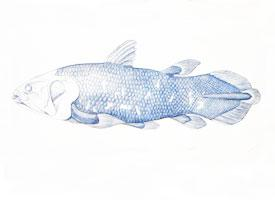
Váhy a míry
| Délka | 1 m |
|---|
Stav ohrožení
| Ohrožen |
Popis zvířete
The West Indian Ocean coelacanth, scientifically known as Latimeria chalumnae, is an extraordinary creature that presents a living link to the fishes that walked the earth over 360 million years ago. This remarkable species, once thought to have gone extinct with the dinosaurs 65 million years ago, was discovered alive in 1938 off the east coast of South Africa. This discovery stunned the scientific community and has since made the coelacanth one of the most famous "living fossils" in the world.Latimeria chalumnae typically dwells in the deep, dark waters off the Comoros Islands, Madagascar, and along the East African coast, preferring underwater caves and volcanic slopes at depths ranging from 100 to 700 meters. This elusive fish is notable for its distinctive appearance, which has remained relatively unchanged for millions of years. It can grow up to 2 meters in length and weigh as much as 90 kilograms, making it a substantial creature.
The body of the West Indian Ocean coelacanth is covered in tough, cosmoid scales that act as armor, a characteristic of ancient fishes. Its coloration is a deep blue or bluish-grey, helping it blend into the dark ocean depths. One of the most striking features of Latimeria chalumnae is its lobed fins, which resemble primitive limbs and move in a unique, alternating pattern. This has led scientists to speculate about the evolutionary relationship between coelacanths and the first tetrapods that ventured onto land.
Another fascinating aspect of this species is its method of locomotion, known as "intra-fin swimming." This involves the coelacanth moving each of its lobed fins in a sequence that gives the appearance of a slow, hovering flight through the water. This method of swimming is rarely seen in other fish species and adds to the coelacanth's mystique.
The West Indian Ocean coelacanth is an ovoviviparous species, meaning the females give birth to live young after the eggs have hatched inside her body. This reproductive strategy is relatively rare among fishes and indicates a complex life history that is still not fully understood. The gestation period is believed to be lengthy, possibly up to three years, with the female giving birth to a small number of well-developed juveniles.
Despite its fame and scientific importance, the West Indian Ocean coelacanth faces threats from accidental capture in commercial fishing gear, habitat destruction, and the effects of climate change on its deep-sea environment. Its rarity and the depth at which it lives make studying and conserving this ancient species particularly challenging.
In summary, the West Indian Ocean coelacanth, Latimeria chalumnae, is a fascinating and rare creature that provides invaluable insights into the evolutionary history of vertebrates. Its discovery has challenged our perceptions of extinction and survival, making it a symbol of hope and a reminder of the mysteries that the deep ocean still holds. Conservation efforts are crucial to ensure that this ancient fish continues to thrive in its deep-sea habitat, preserving a living piece of Earth's distant past for future generations to study and admire.
Nové fotografie zvířat
Top 10 zvířat
- Chinese water dragon (Physignathus cocincinus)
- Galápagos tortoise (Geochelone nigra complex)
- Dolphin gull (Leucophaeus scoresbii)
- Japanese macaque (Macaca fuscata)
- Colombian red howler (Alouatta seniculus)
- Sea urchins (Echinoidea)
- Moustached guenon (Cercopithecus cephus)
- Diana monkey (Cercopithecus diana)
- Common reed warbler (Acrocephalus scirpaceus)
- Common house mosquito (Culex pipiens)